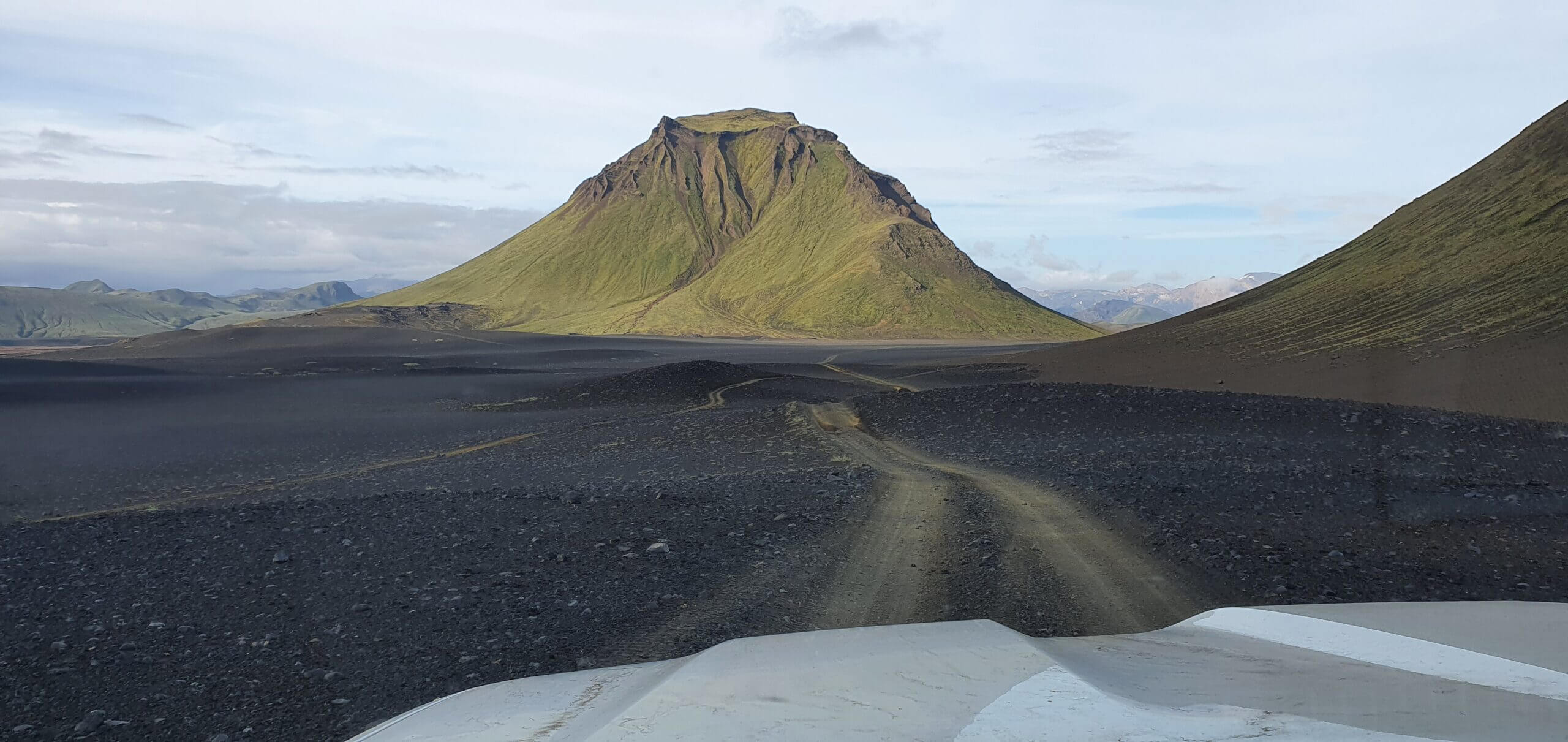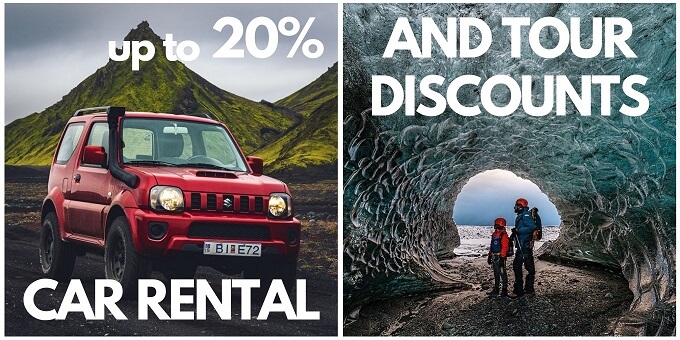If you ask a typical tourist if they have visited Fjallabak reserve in the Icelandic Highlands, they would probably give you a weird look asking something like “What is Fjallabak reserve?”. And that’s exactly one of the reasons why we definitely wanted to visit Fjallabak roads 🙂 Not many people tend to go there.
The reason is, it’s not that easy to find information about beautiful places over the Fjallabak, and last but not least it’s not so easy to get there. You definitely need a good car for that. And still, almost every tourist surely has visited Fjallabak once, because that’s where also famous Landmannalaugar is located.
The weather slowly started to get cloudier and rainier in the south so we had to pick our next destinations really carefully. Our accommodation was near Hella, so there were still plenty of options to go at. One of the areas where the weather was supposed to be nice (i.e. not rainy and hopefully not foggy) was the Fjallabak nature highlands reserve. Fjallabak, i.e. the area around roads F210 and F261 was on the top of our list anyway, so it was an easy choice for Day 2 of our Highlands trip.
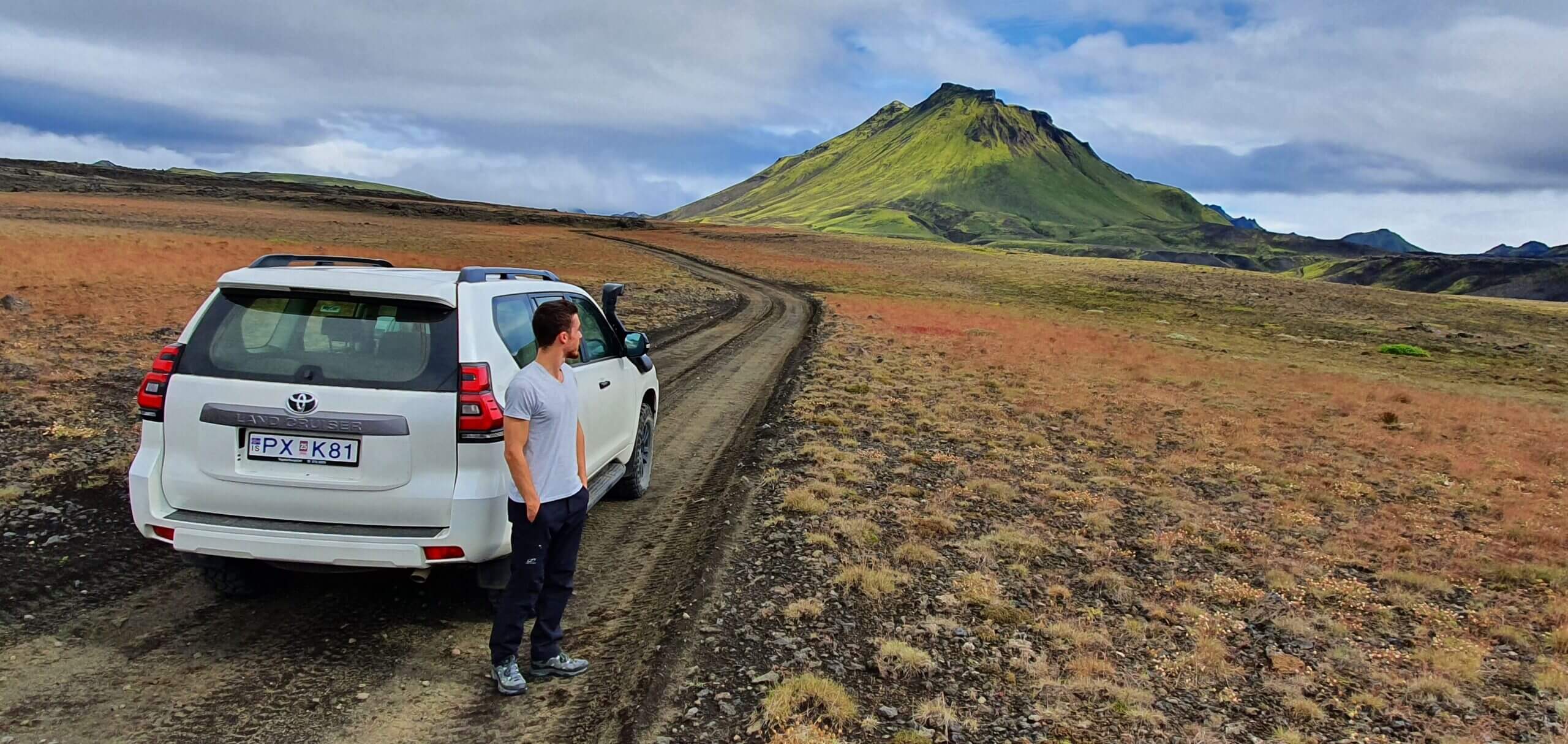
F261 near Markarfljotsgljufur canyon
Contents
- Highlands of Southern Iceland
- How to get to Fjallabak – F210 and F261
- 1. F210 west to Alftavatn
- 2. Alftavatn
- 3. F210 east towards Maelifell
- 4. Maelifell
- 5. F210 east towards Raudibotn
- 6. Rauðibotn highlands
- 7. F210 south to Markarfljotsgljufur canyon
- 9. Highlands around Hungurfit track
- 10. F261
- Fjallabak highlands Videos
Highlands of Southern Iceland
Our plan for the day was to drive the road F210 starting from the west (Hella side), stop at Alftavatn campsite/lake, and admire the surroundings of the magnificent F210. Next, if the weather and road conditions allowed, we planned to drive to legendary Maelifell and if we had enough time and courage, also to Rauðibotn.
Raudibotn is a remote place away from all of the tourists, hard to access, yet stunningly beautiful. At least that’s what I managed to find out from scarce sources beforehand. To get there, however, you need to cross the Holmsá river, which can get really dangerous at times, so we left it as an optional activity if the crossing looked safe only.
Then we planned to come back via F210 around Maelifell to go see Markarfljotsgljufur canyon, which was said to be one of the most beautiful, yet still pretty hidden. Then, if we still had some time a friend of mine suggested an adventurous 4×4 track leading north in between F261 and F210 to Hungurfit hut. He said our (slightly) modified Land Cruiser should be just enough to drive the route.
How to prepare for the Icelandic Highlands Road Trip
Our friend also mentioned to us a really remote hot spring – Strutslaug – but we saved that one for another day. Yes, a very packed day, but still pretty flexible, because we could basically cancel any activity if it seemed undoable. And that’s what everyone should plan for I think – anything should be cancellable, just in case.
How to get to Fjallabak – F210 and F261
No, there’s no bus here, such as the one in Thorsmork. The only way to get to F210 is by taking a guided tour (10% discount code: EPICICELAND10) or driving there by yourself (a time-consuming option demanding planning, experience, and driving skills). We naturally opted for the second option.
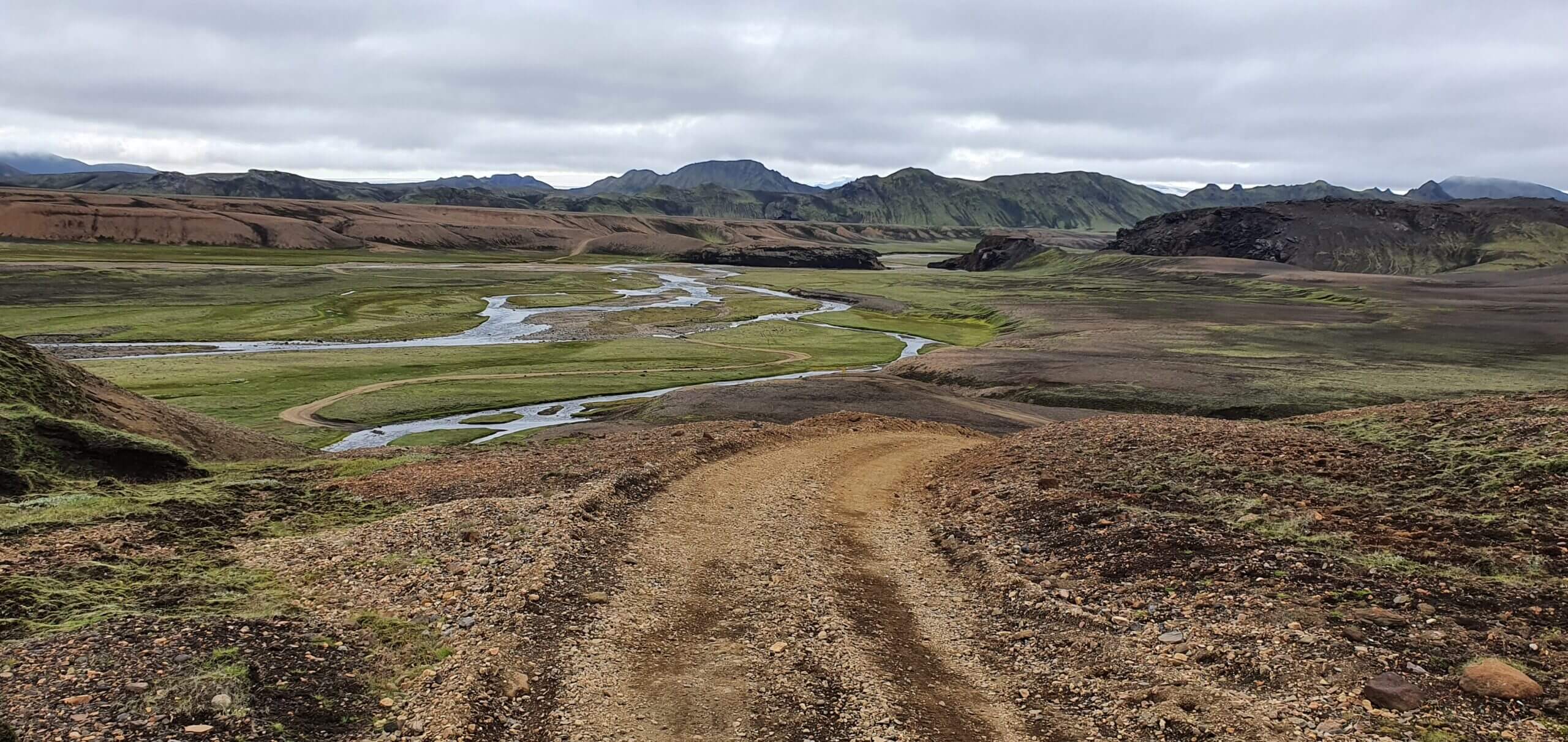
F210 (Fjallabaksleid sydri) between Keldur and Alftavatn
Most of the F210 is without bigger river crossings, so in case of good weather, even if you don’t feel like doing bigger river crossings, you may try to drive it in a proper 4×4 (ideally Land Cruiser or bigger, see our guide on how to choose a proper car for Iceland) – up to Alftavatn mountain hut.
We can also take you here on our Epic Private Tour, just email us.
Up to Alftavatn hut, the road is just bumpy, with potholes and some steep sections, but really picturesque and one of my favorite Icelandic roads. You will get amazing views in each direction – seeing Landmannalaugar from the distance and a big part of Fjallabak Park.
1. F210 west to Alftavatn
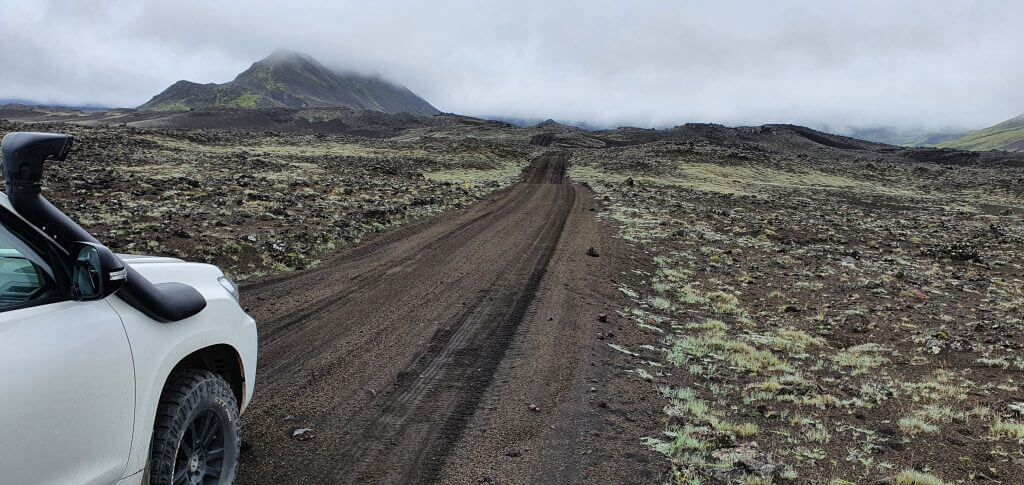
F210 west near Keldur
Even until Alftavatn, you will still have to cross several smaller streams, and even drive in the riverbed for around 100 meters! This is really one of the “once in a lifetime” experiences, for anyone not used to it (yes, maybe not for Icelanders ;).
As I mentioned, the road leads through multiple mountainous areas, so if you are unsure about driving in such an environment, please don’t go. Once you pass Alftavatn, the first real obstacle gets into your path – crossing the Kaldaklofskvisl river.
Kaldaklofskvisl crossing on F210 can get tricky at times because there are some large boulders in the river that you are unable to see beforehand. Secondly, the water level in the river may get too high to allow for safe crossing in vehicles not big enough.
It’s always necessary to strictly adhere to all the river crossing rules, watch someone cross before you, wade the river yourself if feeling unsure, and if still feeling unsure better turn back.

Kaldaklofskvísl river crossing
2. Alftavatn
We had nice partially cloudy/partially sunny weather, luckily with no fog and no rain. We already knew from our friends and from the day before, that the water level in rivers is favorably low and rivers are shallower than usual. These are practically one of the best conditions possible.
Hence, we drove F210 all the way to Alftavatn lake. The road was admiringly beautiful. The part I liked the most was the highest spot just before Alftavatn, where you could see all the surrounding land, including Landmannalaugar in the distance, almost from the “bird’s eye” point of view.
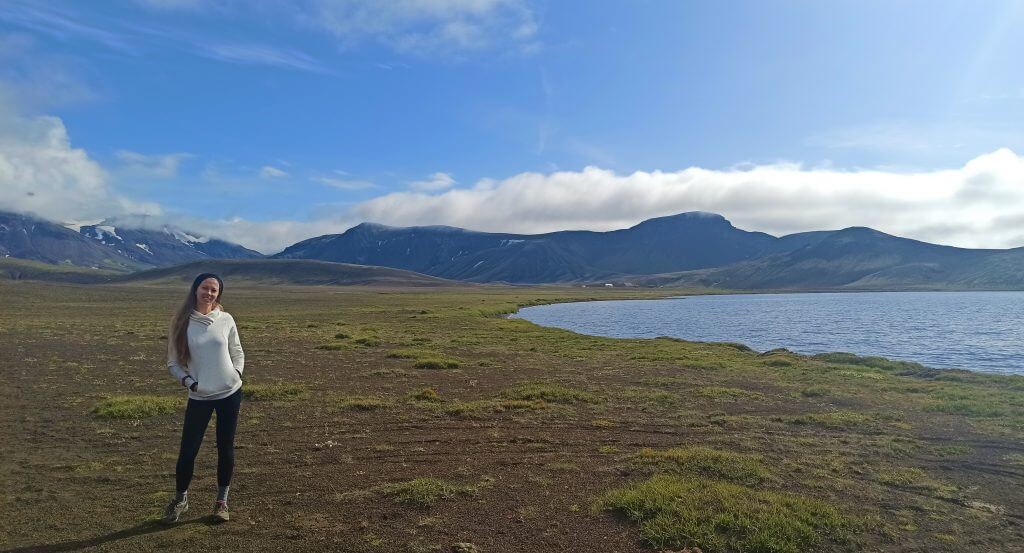
Álftavatn lake
We took a short break at Alftavatn lake, which is a very nice, calm, and quiet spot to stop at and have a picnic or short stay during nice weather. We were lucky enough that exactly after our arrival at Alftavatn the sun started to fight its way between the clouds and we could even walk in the T-shirt outside.
3. F210 east towards Maelifell
F210 after Alftavatn then continues in two directions – south towards F261 and east towards Maelifell and Holmsa river. Since our journey went smoothly up to this point, we definitely wanted to take a detour toward Maelifell and so we did. We turned left on the eastern part of F210. Here’s where the truly lunar landscapes have begun to emerge.
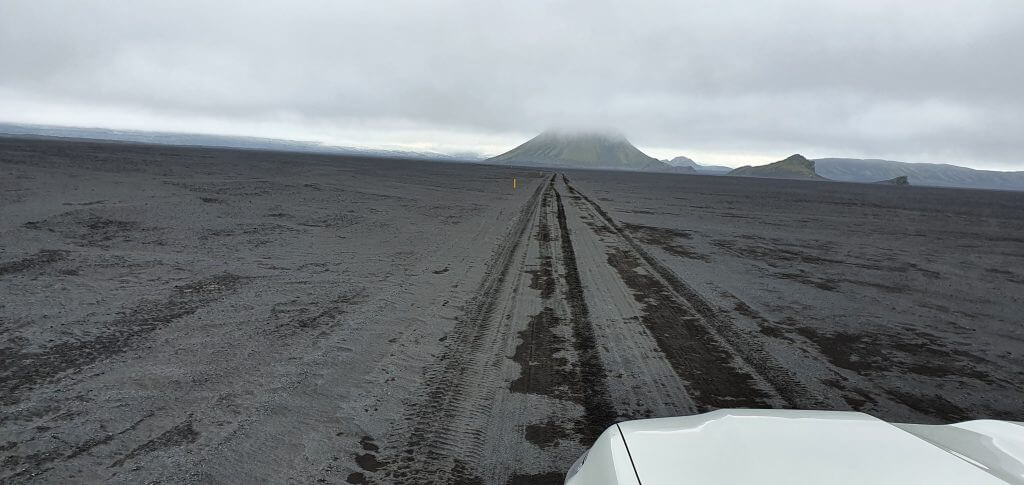
F210 Fjallabaksleid Sydri east to Maelifell
F210 towards Maelifell is definitely one of the most unique Icelandic roads. Firstly, the weather almost always changes when driving on this road. F210 towards Maelifellsandur literally feels like a gateway towards another world, thanks to this. Secondly, the road itself is very specific – it starts with huge boulders and continues as a black sand road.
And it’s almost always covered with some kind of mist – either light or heavy. Huge boulders are the most difficult part of F210 towards Maelifell. The road doesn’t have a clearly visible track, and if you don’t take enough care, you may damage the underside of your car.
Read our guide on how to choose the best car rental insurance for Iceland.
After basically driving on huge stone plates rather than an ordinary road, the route turns into tracks in the black sand. Oftentimes expect it to be wet and muddy because this is the area where it may rain occasionally. This part of the road doesn’t have any huge obstacles, or rivers, so it looks like a giant moon highway.
There are no more river crossings going from Kaldaklofskvisl to Maelifell. If you are the only car on the road (which is frequently the case, as with us) then your only guides are the tracks in the sand and yellow sticks marking the side of the road.
4. Maelifell
After a drive in the middle of “black sand nowhere”, you will be able to spot majestic Maelifellsandur in the distance. If you are lucky enough, and Mr. Maelifell is not covered in fog – which he likes to do – your view will be truly amazing. As I already mentioned, the weather usually changes to worse after turning towards Maelifell. This was exactly our case (multiple times). This time it, however, only changed to cloudy with occasional little rain – which is still considered good weather.
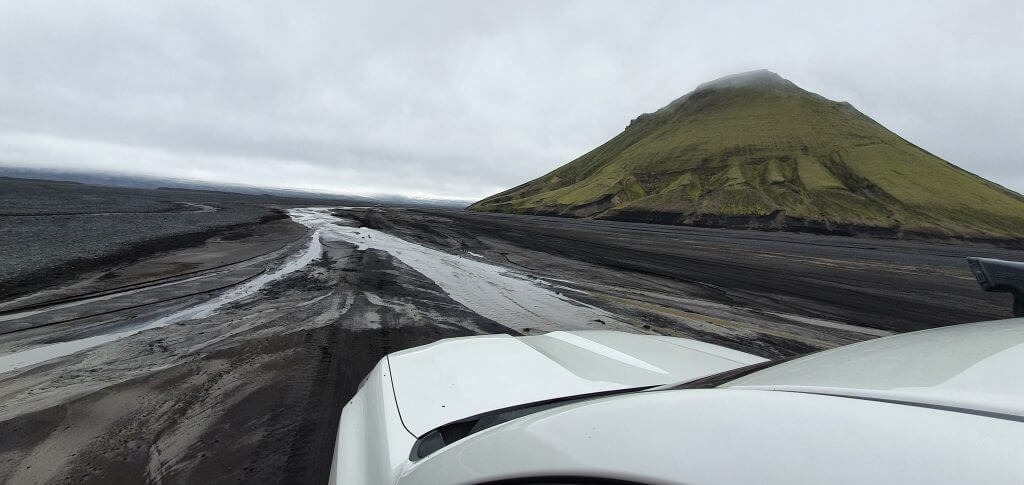
Maelifell in Fjallabak nature reserve
Finally, after an adventurous drive – there it stood – Maelifell volcano. It’s a view as if you were on a deserted planet. A huge green volcano in front of you, surrounded by black sand fields, with occasional little lakes created by past rain and absolute silence in the air.
It’s even possible to climb the Maelifell, but we don’t recommend doing that unless you are really experienced in performing steep, unmarked hikes unless there’s ideal weather and ideally only with a guide. We didn’t go for the hike as it may be really dangerous (and the view from above wouldn’t be great in partially foggy weather).
5. F210 east towards Raudibotn
We still had enough time at that point of the day, because everything went pretty smoothly. Thus, we decided to take a look at the Holmsa river crossing with an aim of seeing Raudibotn – the beautiful hidden (from a typical tourist) area with a crater, river, and amazing landscapes all around.
After reaching Maelifell, we continued east and we soon arrived at the Holmsá river crossing. According to a friend of mine, the crossing was supposed to be doable, without problems, at this time of the year (especially due to low water levels). Beware, this is the river crossing which may get pretty nasty. Always check both beforehand and on-site.
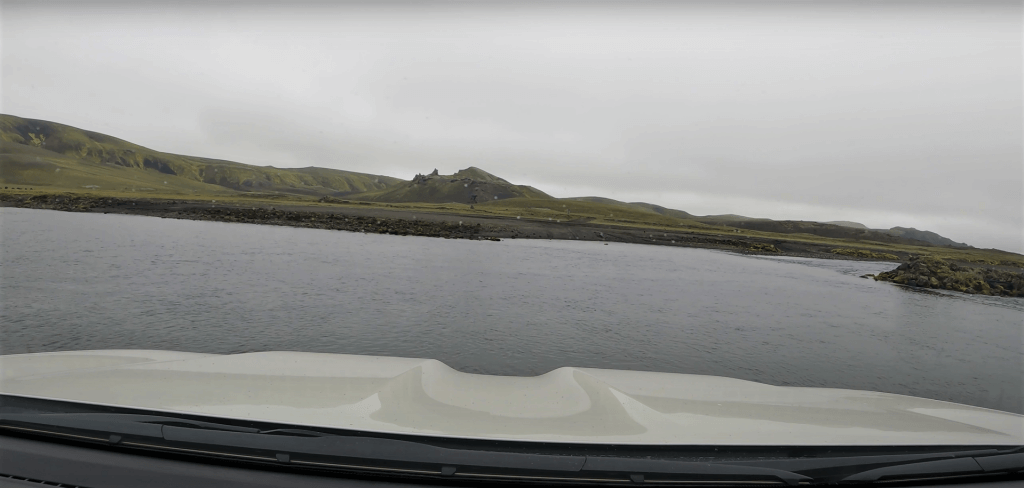
Holmsá river crossing at F210
The crossing looked exactly like my friend Haraldur described it – this time harmless. I examined the river anyway and it looked calm and shallow. Because of this, we decided to go for a ford even without wading the river on foot. And the crossing went smoothly. There’s a small hill with the road, usually easy to spot on your left after the Holmsa crossing.
The road ends soon at the improvised clay car park for a few cars. There was only one car other than us already parking at the spot. We just saw a crew of this car in the distance when arriving at the place and they were apparently heading back, so we decided to wait on them and ask about the route.
6. Rauðibotn highlands
In spite of having read already about the place, it wasn’t very clear from that article where to proceed. It was also unclear if it was possible to make a round trip (via different trails) or just to use the same way there and back. Thirdly, it wasn’t clear how much time should we devote to the entire trip. Once the group, which turned out to be the French family, came back, I asked them if it is worth making the hike, to which they immediately replied “Yes, it’s stunning”.
The second thing I asked was how long it takes to do the hike. They replied “3 hours”, although I’m not completely sure they understood me because, in reality, the little hike took us much less – around 1,5 hours. My last question was if they had done the roundtrip via 2 different routes. The answer I got was “No, I don’t think so unless you want to climb up to the volcano”. OK, thanks, some useful info 🙂
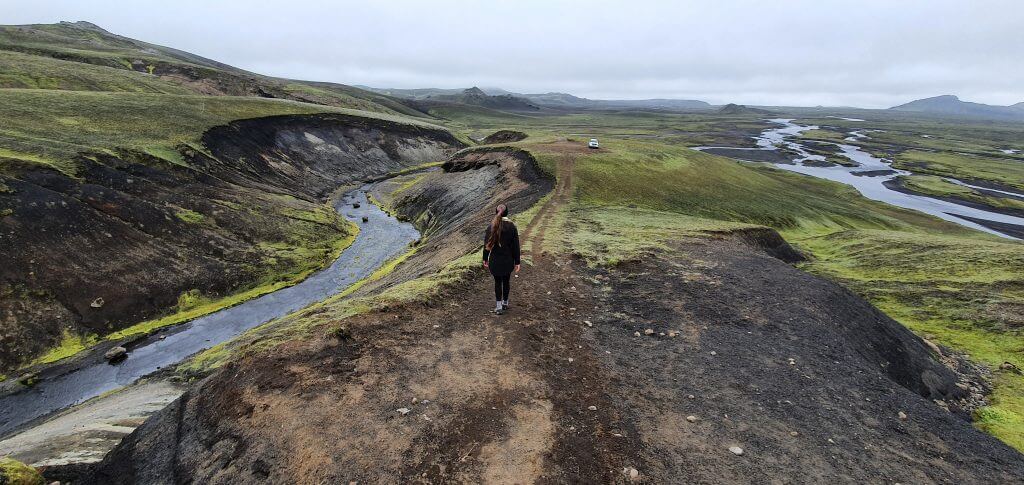
Rauðibotn parking
Raudibotn trail
The trail towards Rauðibotn starts as a steep quad-bike track (I wonder who had driven up this steep hill, I wouldn’t…). It then turns right down the hill towards the picturesque green valley surrounded by a river, a volcano hill, and a lot of moss. Speaking of moss – please really do your best to NOT step on it – it takes ages for it to grow again and sometimes it will even not grow anymore. As we found it a bit difficult to orientate in the area, we put together a simple map of Raudibotn for you:
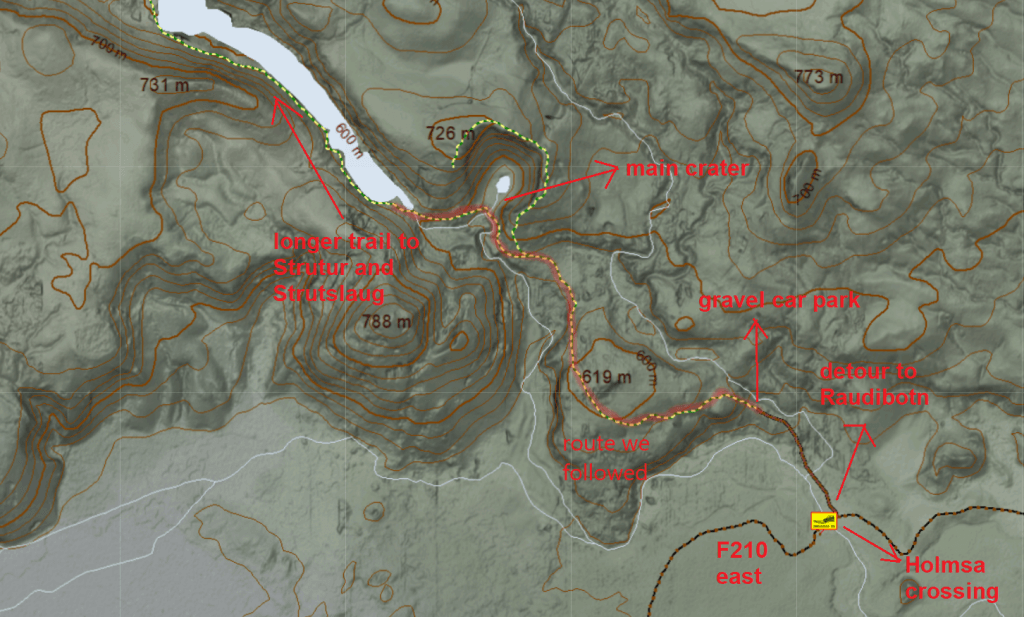
Map of Rauðibotn
The trail is not marked. The only way how to follow the trail is to look for the tracks, which are, however, most of the time easy to find. An entire area has an amazing lunar charm, where you once again really feel like on another planet. This time one which is greener and filled with a lot of water.
After roughly 30 minutes of following the trail, we arrived at the beautiful crater where the mist literally traveled up and down in the air. In the background, there was an amazingly red crater and the entire place was really pretty and definitely worth visiting. Even in cloudy and partially foggy weather which we experienced.
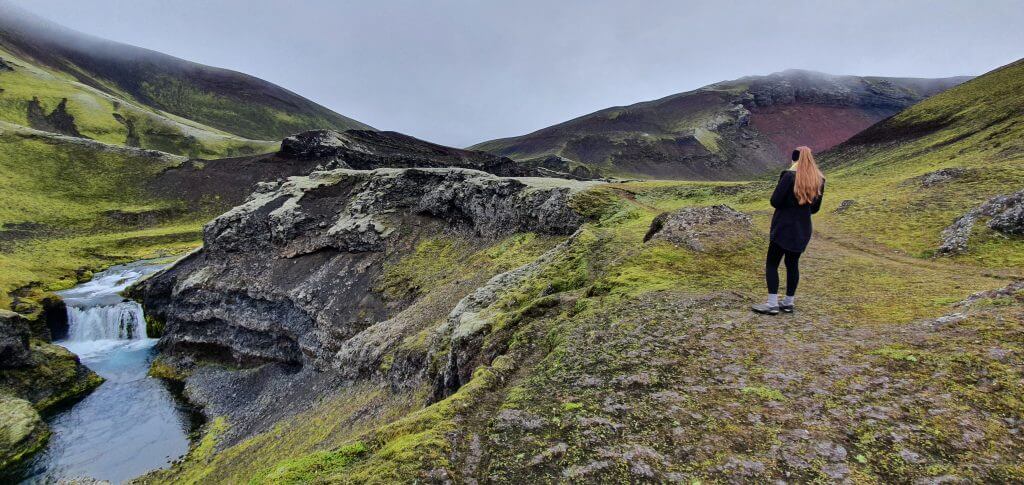
Raudibotn waterfalls
At that point, we tried to discover whether it was possible to come back via a different route or not. The article I had read mentioned that in order to do that you need to ford the river – but the river didn’t look fordable at all – the current looked too strong. Even when looking at the map, there didn’t seem to be an option to ford the river. Thus, we concluded – no ford – only the same way back.
The road, however, continues further next to the river all the way toward Strutslaug’s hot spring area. So, if you are into remote hiking and if you have enough time (and can somehow plan it all) feel free to proceed even further.
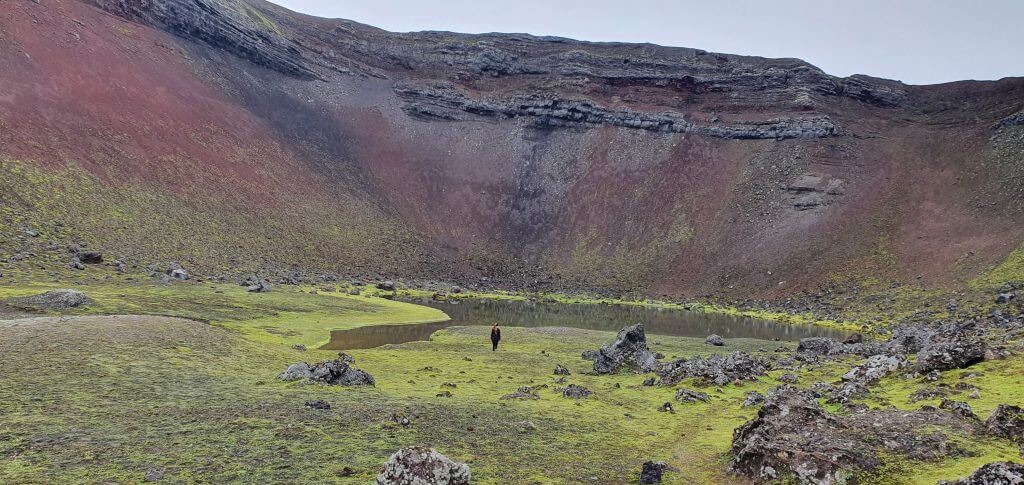
Rauðibotn volcano crater
After shortly examining the road further in the direction of Strutslaug (i.e. the one leading next to the big lake), we turned back and arrived at our car park via the same trail. And yet, the day still had not ended for us. One of the last stops I planned for the day was located on the way back, near the southern part of F210.
Hence, next, we drove back through Holmsa crossing, next to Maelifellsandur, and back to the F210 crossroads. At the crossroads, we turned left and headed towards our next stop – Markarfljotsgljufur canyon.
7. F210 south to Markarfljotsgljufur canyon
There are two major river crossings on the F210-F261 roundtrip. The first one is the Kaldaklofskvisl River, after Alftavatn and the second one is the Blafjallakvisl River further down F210 to the south (after not turning towards Maelifell at the crossroads). Our friend Haraldur told us that if we succeed in crossing Kaldaklofskvisl, then Blafjallakvisl will be easy because it’s a smaller crossing.
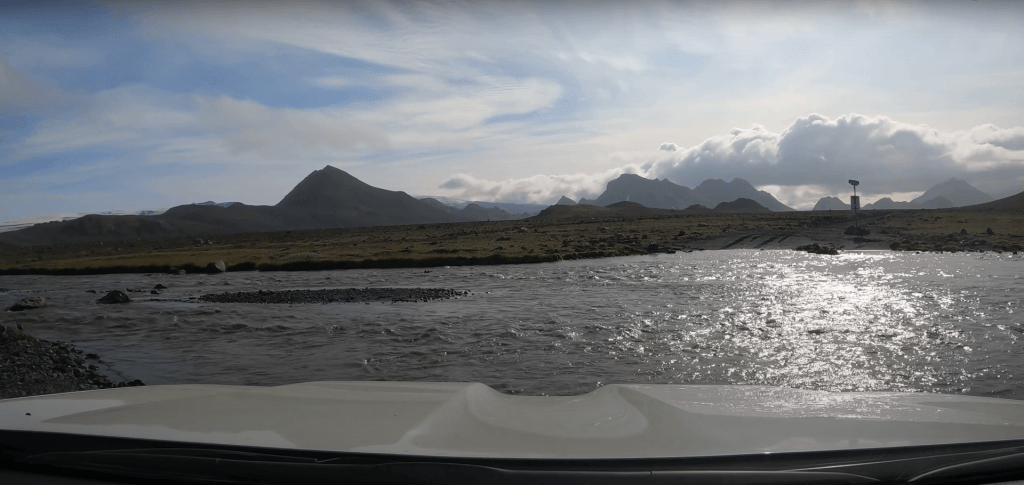
Bláfjallakvísl river crossing at f261
You can watch how we crossed the Blafjallakvisl river at F261 here. And we crossed it the wrong way. You may see in the video how our car struggled in the middle of the crossing, splashing a huge amount of water. This is exactly what you shouldn’t do. Luckily, our Land Cruiser has survived without any damage thanks to a snorkel and high ground clearance.
What happened here was that we, firstly, went too fast (overconfidence maybe?) and, secondly, probably took the wrong path. The river bed was very uneven and we fell into the deeper part with our car. All of this could have been avoided, had we waded the river by foot beforehand.
10% discount code for the best Fjallabak super jeep tour in Iceland: EPICICELAND10
After crossing Blafjallakvisl, we headed towards the Emstrur hut to see the Markarfljotsgljufur canyon from the eastern side.
How to get to Markarfljotsgljufur Canyon
There are two ways to get to the Markarfljotsgljufur – from the west and from the east. A little warning in the beginning – neither of the roads leading there is easy. On Day 2 of our trip, we decided to take the eastern route, from the Emstrur side. On Day 5, on the other hand, we decided to see Markarfljotsgljufur canyon from the west.
This is the map of Markarfljotsgljufur canyon access roads and the way we took:
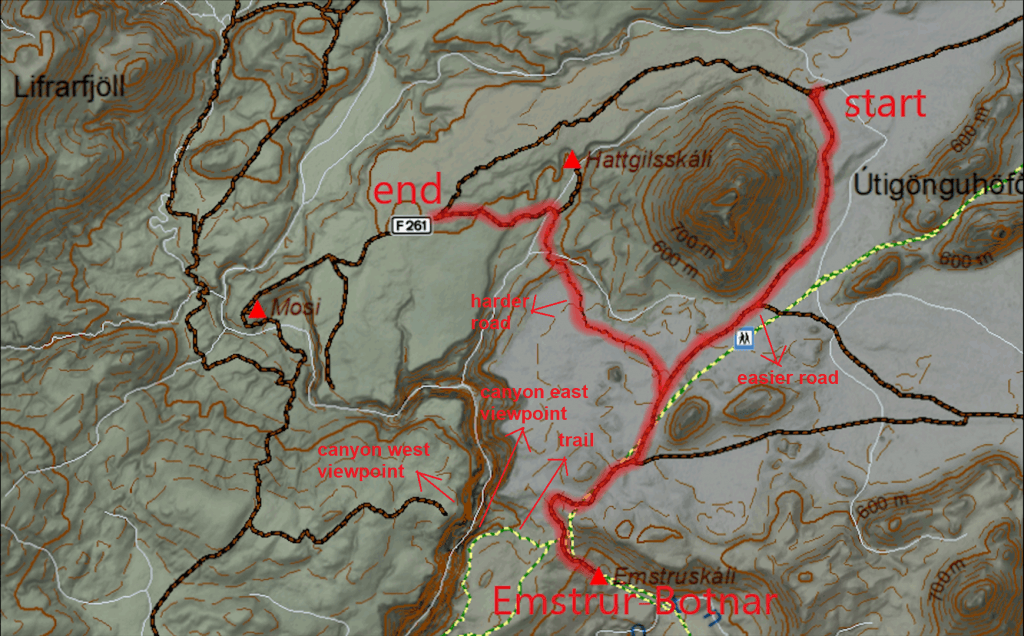
Markarfljótsgljúfur canyon map and roads
Beware, the Emstrur tracks we drove are just dirt tracks. Not even F-roads. This means they are even harder to drive than F-roads. Always check with your rental company if it allows for such roads, choose your car wisely, and study the roads in advance. Mostly only super jeeps are allowed to drive the dirt tracks.
When taking the eastern route, you have to make a detour from F210 towards Emstrur hut. There are actually two different paths – the northern one and the southern one. We took the northern one on our way there and the southern one on our way back. Both were pretty scary even in our (slightly) modified Land Cruiser.
The northern route leads primarily to the Emstrur hut. It’s a steep gravel road where you have to drive very slowly, in low gear, with 4×4 turned on, and beware of any mistakes like hitting the big stones.
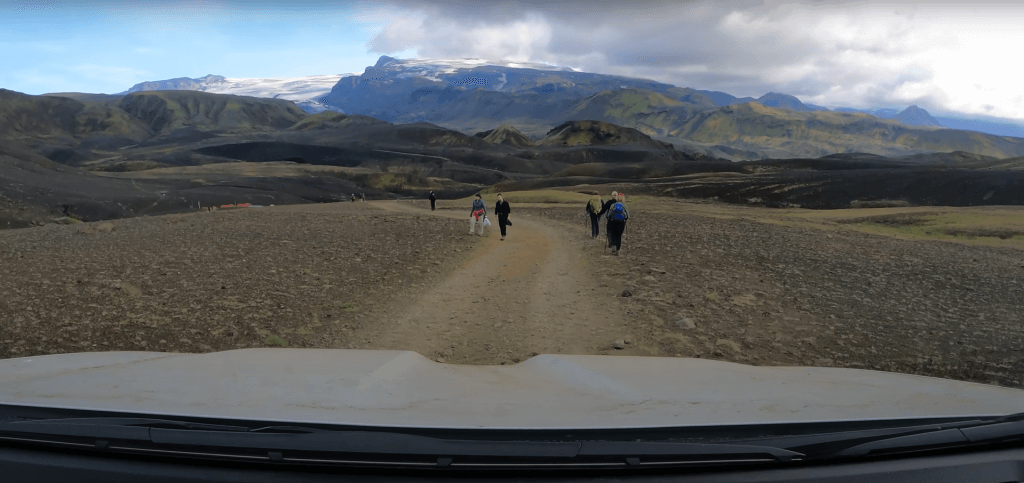
Emstrur track (northern part) to Markarfljotsgljufur
When looking at the map, the Markarfljotsgljufur canyon was supposed to be located right to us, but we weren’t able to see any detour leading there. So we ended up parking our car at the Emstrur campsite. We were the only car with tires smaller than 40” there, and the locals gave us some curious looks (apparently not many travelers come here by car, and most of the time locals only).
We asked at the hut where to proceed to see the canyon. They advised us we should come back a little by car, leave the car there and then follow the hiking trail on foot. We did exactly as we were advised.
There’s a little wooden sign saying “canyon”, not very well visible, which we apparently missed. Next to the sign, there’s a place to park a few cars, so we left ours there (as the only car). We continued by walking. It takes around 10 minutes to reach the edge of the canyon. And hell, the walk is completely worth it 🙂
Markarfljotsgljufur Canyon from the east
I’m not sure if this is the biggest canyon in Iceland but it definitely looked like it. Seeing Markarfljotsgljufur was a once-in-a-lifetime experience, which cannot even compare to seeing the over-touristy Fjadrargljufur canyon or other similar places. At least for us.
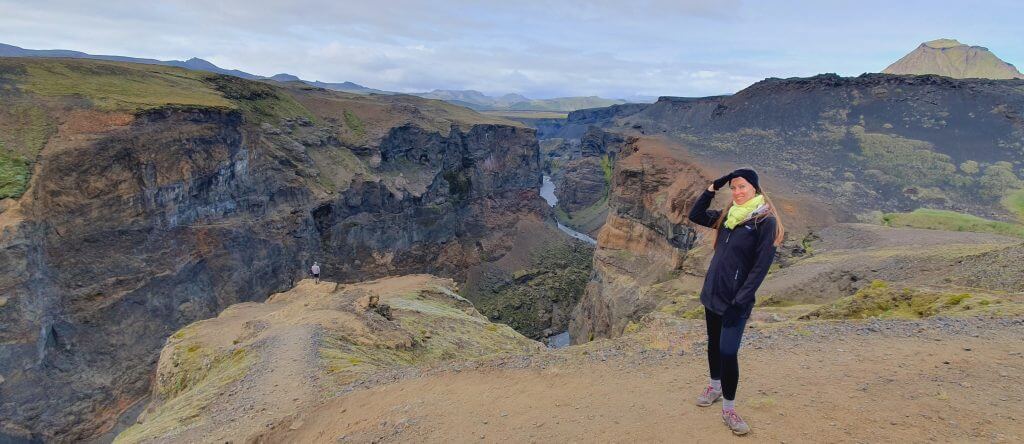
The east viewpoint of Markarfljótsgljúfur Canyon
Surprisingly we were not alone here, with maybe 2 or 3 other couples admiring the place. The reason is simple – Emstrur hut serves as a shelter along the famous Laugavegur trail. At the time we reached the canyon, it was already time when most of the hikers had already arrived at the hut and were spending their late afternoons doing this little hike towards Markarfljotsgljufur.
The views from the edge of the canyon are more than just stunning. It’s also possible to hike along the edge of the canyon. Take great care though, this place doesn’t have any ropes or barriers to keep you safe from falling off the giant cliffs. The biggest plus of Markarfljotsgljufur is definitely its remoteness, which means you definitely won’t meet many fellow tourists here.
How to get from Markarfljotsgljufur
As I already mentioned above, to get to or from Markarfljotsgljufur from the eastern side, you may use two roads – both detours from F210. One northern and one southern. We used the northern detour to get there and the southern detour to get back. However, if you don’t have a huge car and you don’t like damaged roads, I don’t recommend you take the southern one.
The southern detour is an old broken track leading towards Hattgilsskáli hut. I don’t remember any major river crossing, but I definitely do remember a track in some bad condition. This southern detour from Emstrur-Botnár is a short, yet pretty intense, steep, and difficult-to-drive track. Broken stones and boulders are all around the track and huge holes meet you at every corner. At one point my wife was so scared she simply got off the car and continued walking (and shooting my drive ^^).
Once you reach the highest point of the track, the steep descent follows, once again with some huge holes which cannot be avoided, because the track is narrow and there’s a hill on your left side and a steep fall on the right side. Yes, this track from Emstrur is definitely doable in a proper car and with proper skills, but it’s not a very pleasant experience, I wouldn’t take it again. At one point our 33” Land Cruiser had two wheels in the air and I felt like this is the edge of what this car can make and I shouldn’t push further.
Anyway, with some slow driving and checking the track frequently, we eventually made it back to F210 and still had some spare hours, even though the dark was getting close. I persuaded my wife to try at least for a while the track our friend Haraldur recommended to us, the track towards Hungurfit hut.
9. Highlands around Hungurfit track
Some tour guides say they will take you to impassable places and this is exactly one of these places 🙂 Please don’t even try without enough experience in 4×4 driving, steep hills, narrow roads, and river crossings. And preferably a super jeep, or at least a Land Cruiser-like vehicle. Our friend was right, though, and the track toward Hungurfit hut is definitely one of the most exciting (and difficult) tracks I’ve driven in Iceland. Due to the shortage of time, we decided to drive only less than half of it – the circular round trip. However, in the following days, I decided to come back and do the whole track.
Beware, the Skaelingar and Blautulon tracks we drove are just dirt tracks. Not even F-roads. This means they are even harder to drive than F-roads. Always check with your rental company if it allows for such roads, choose your car wisely, and study the roads in advance. Mostly only super jeeps are allowed to drive the dirt tracks.
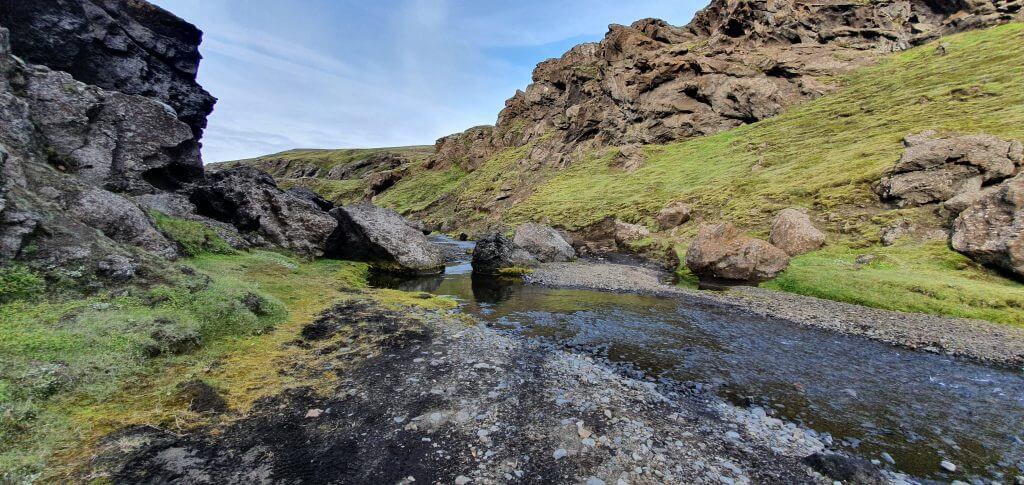
Hungurfit track between F210 and F261
There’s no proper road service on this road, so expect it to be difficult to drive. Big gravel and narrow steep hills are a certainty. Other than that, there’s one (not just one, to be precise) specialty at the track towards Hungurfit hut why all these guides and even locals go have some fun in here.
Once you reach the first fork/crossroads you may choose – the track towards the left leads through a gorgeous area full of little river crossings and one surprise. On the other hand, the track towards the right leads through a mountainous area with beautiful views. We’ve done the whole roundtrip.
Left and right turns from the track towards Hungurfit hut
We started with a track towards the left and descended towards an area full of small river crossings, which, for me, was a once-in-a-lifetime experience. Of course, we were completely alone there. On the one hand, this was amazingly beautiful, on the other hand, it was a bit scary as well. I definitely wouldn’t want to get a flat tire in here or get stuck in the river. Forget about any cell phone signal or internet connection. Just you and the rough Icelandic highlands.
Taking the left detour at the beginning of the track towards Hungurfit hut you will soon arrive at the famous spot, which is the reason behind so many locals going in here. There are two giant stones on both sides of the road, making the road so narrow that you may pass only with a few centimeters of free space on both sides of your car.
At the same time, the track obviously isn’t flat underneath your car. There’s another huge stone on the ground, followed by a big hole and another sharp stone. So you would need to maximize your patience (and driving skills) to pass through without any damage to your car.
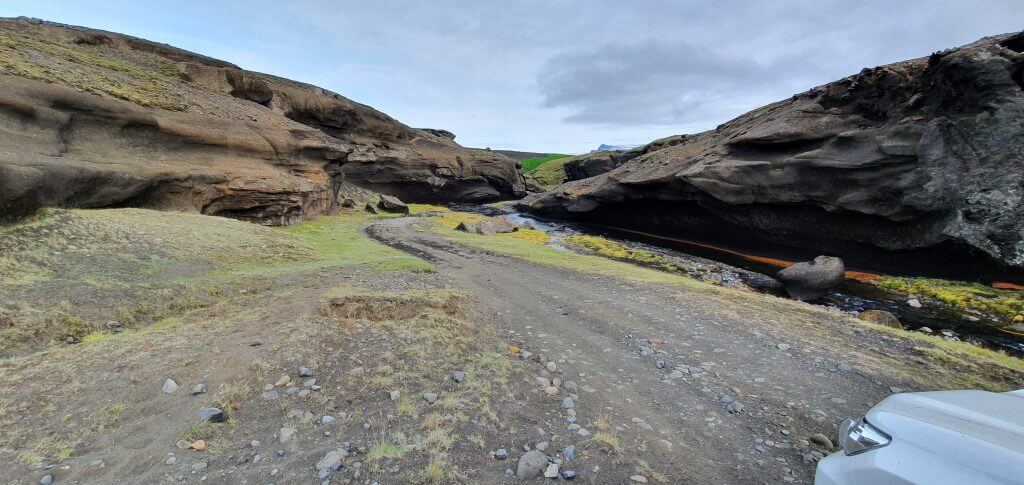
Hungurfit track
I took enough time to study the passage and to check whether everything is fine for me to pass and we passed well. The river crossing area then continues for a while and then you’re gonna connect to the right detour. From there, you may either come back (as we did this time) or continue around 50 kilometers all the way toward the northern part of F210 (as we did next time).
We came back via the right track, which was similarly exciting, just in a different way – some more steep and narrow passages with potholes. You can watch the entire video of our Hungurfit round-trip here.
10. F261
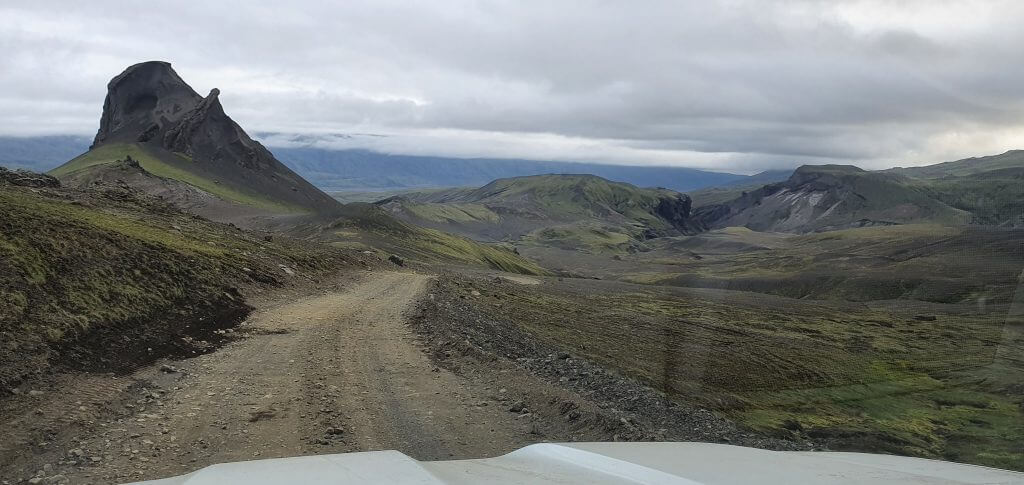
F261 Emstruleið
It was already evening, so we had to head back. We completed our round trip via F261 back towards Hella. F261 doesn’t contain any major river crossings, only Blafjallakvisl at the beginning (next to F210). And, as I mentioned above, Blafjallakvisl was easy this time and generally should be easier than Kaldaklofskvisl (if crossed correctly).
F261 near F210 is composed of big gravel and some steep sections so you have to drive slowly and the drive is not that comfortable. It’s definitely possible to drive F261 also in an SUV like Dacia Duster, although I cannot imagine how uncomfortable it has to be.
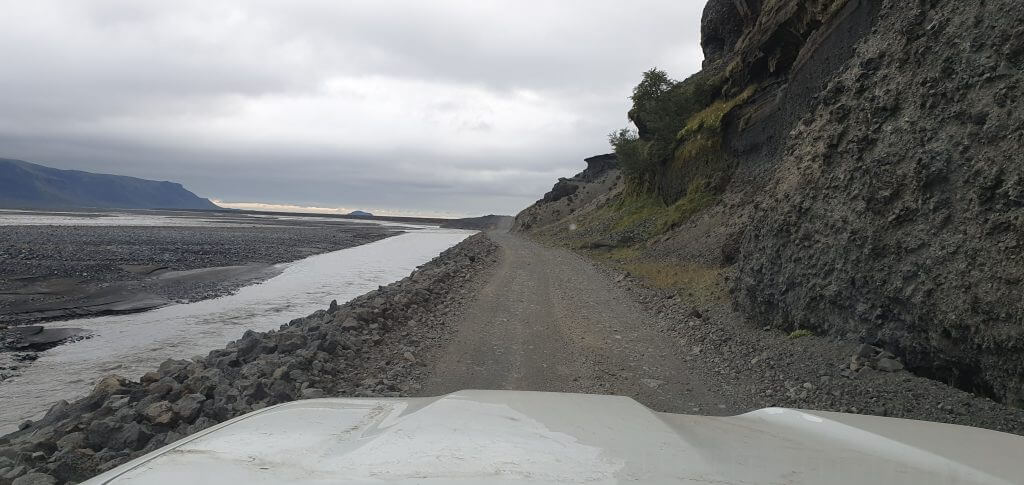
F261 near Fljótshlíð
You can watch the entire video of our F261 drive here. The western part of F261 basically leads to the other bank of the Krossá river and you are able to see the Thorsmork area and F249 well from it. Even this part contains a lot of big gravel and the drive has to be slow and not very comfortable. The scenery is beautiful as always, although for me F210 was even more picturesque. This may, however, be due to the effect that we had seen F210 first 🙂

